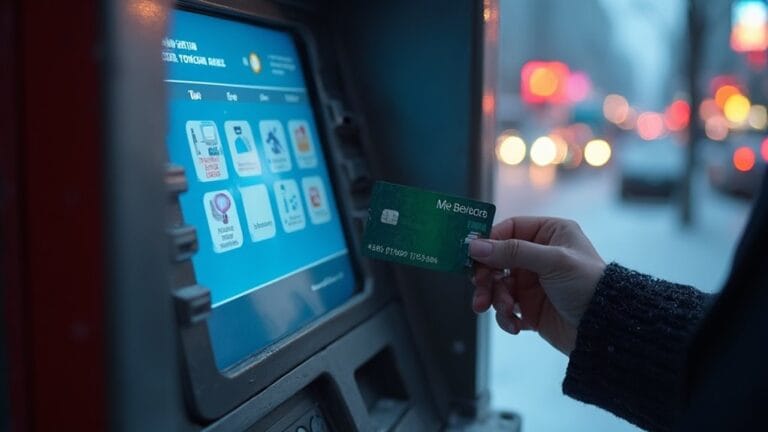When traveling between the U.S. and Canada, you'll want to watch out for five sneaky credit card fees that can eat into your vacation budget. Foreign transaction charges typically hit you with 2.5-3% on purchases, while ATM withdrawals can stack multiple fees up to $9 per transaction. Currency exchange rate markups add another 2.5%, and if you're thinking about cash advances, expect to pay $7.50 plus immediate interest up to 29.99%. The real kicker? Dynamic currency conversion can add a whopping 6% to your bill. Understanding these fees is your first step to smarter cross-border spending.
Key Takeaways
- Foreign transaction fees typically range from 2.5% to 3% when using U.S. cards in Canada or Canadian cards in U.S.
- ATM withdrawals can cost up to $9 per transaction due to combined account fees, network fees, and convenience charges.
- Currency exchange rate markups add 2.5% on average, with traditional banks charging both markup and transaction fees.
- Cash advances incur immediate fees of $7.50 plus ATM charges, with interest rates up to 29.99% starting immediately.
- Dynamic Currency Conversion (DCC) can add 6% to transaction costs when merchants offer to convert charges to home currency.
Foreign Transaction Charges
Credit card's foreign transaction charges can quickly add up when traveling between the U.S. and Canada. You'll find that most U.S. credit cards slap on a hefty 3% fee for every purchase you make across the border, while Canadian cards typically charge 2.5%. It's like leaving a generous tip every time you swipe your card – except this one's going straight to your bank!
Let's break it down with some real numbers that'll make you think twice. If you're spending $3,000 on that dream Canadian vacation (hello, Banff National Park!), you could be looking at an extra $90 in fees with a typical U.S. credit card. That's enough for a fancy dinner you could've enjoyed instead! The fees vary by issuer – American Express charges 2.7%, while Bank of America, Chase, Citi, and Wells Fargo all charge 3%, split between their issuer fee and network fee. Notify your bank before traveling to prevent your card from being blocked for suspicious activity.
Here's a savvy traveler's tip: you can dodge these pesky fees entirely by getting a credit card that specifically waives foreign transaction charges. Many travel-focused cards offer this perk, giving you nearly perfect exchange rates without the extra costs.
Cross-Border ATM Fees

While credit card fees can eat into your travel budget, ATM charges pose another financial challenge when crossing the U.S.-Canada border. You'll face a triple whammy of fees: your regular account fee, a network access fee, and those pesky convenience charges that can add up to $9 per transaction – ouch!
But don't worry, you're not completely out of luck. Getting cash back during purchases at stores can help you avoid these fees entirely. If you're savvy about where you withdraw your cash, you can dodge some of these fees. For instance, if you're with TD or BMO, you'll find their ATMs sprinkled across both countries, often letting you skip the transaction fees (though you'll still need to watch out for those sneaky foreign exchange rates, typically around 2.5-3.5%). Even better, if your bank belongs to The Exchange Network or the Global ATM Alliance, you might save a bundle on convenience fees.
Here's a pro tip: plan your withdrawals strategically. Instead of making frequent small withdrawals, take out larger amounts less often. And whenever possible, use your credit card for purchases – it's often cheaper than dealing with ATM fees, especially when you're hopping back and forth across the border.
Currency Exchange Rate Markups

The complexity of currency exchange rate markups can leave travelers scratching their heads when crossing the U.S.-Canada border. You'll find yourself maneuvering through a maze of options, each with its own set of fees and hidden costs that can take a bite out of your travel budget.
If you're planning to exchange money, you'll want to steer clear of traditional banks where you might get hit with both a markup and a transaction fee (like U.S. Bank's pesky $10 charge for orders under $250). Instead, consider using your credit card, though watch out for those sneaky foreign currency conversion charges – they'll typically add about 2.5% to your purchases. For the savviest travelers, specialist online services like Wise have become a game-changer, offering rates that can be six times cheaper than traditional options. Planning ahead and monitoring exchange rates daily can help you secure better rates for your currency exchanges.
Here's a money-saving tip: ATM withdrawals often provide surprisingly good rates when you use in-network machines. Just imagine getting $600 CAD for only $396.13 USD – that's barely a half percent over the official rate! Currency exchange offices can also be your friend, typically beating bank rates while keeping those markup monsters at bay.
Cash Advance Penalties

Taking a cash advance on your credit card across the border might feel like a quick fix, but it'll cost you dearly. You're looking at fees that'll make your wallet weep – a whopping $7.50 for international cash advances, plus whatever the ATM decides to charge you for the privilege of accessing your money. And that's just the beginning of your financial adventure!
Here's where it gets really painful: interest starts accumulating the moment you grab that cash, with no grace period to save you. We're talking about interest rates that can soar up to 29.99%, which is about as fun as getting caught in a Canadian snowstorm without a jacket. Plus, you'll be limited to withdrawing only 30-50% of your credit limit, so if you're dreaming of making it rain at the casino, you might need to adjust your expectations. Unlike regular purchases on your card, these transactions won't earn you any reward points.
Before you jump into the cash advance pool, remember that those fees stack up faster than maple syrup on pancakes. You're better off planning ahead and bringing cash from home, or using your regular debit card for withdrawals when possible.
Dynamic Currency Conversion Costs

Many travelers get caught in the Dynamic Currency Conversion (DCC) trap when paying abroad, thinking it's helpful to see charges in their home currency. Don't be fooled – this seemingly convenient service can take a nasty bite out of your wallet! You might be shocked to learn that DCC fees can double your basic foreign transaction costs, potentially adding a whopping 6% to your purchases.
Picture this: you're enjoying a lovely dinner in Toronto, and your bill comes to $113.34 CAD. The server helpfully offers to charge you in USD, showing $87.17 on the receipt. Sounds great, right? Wrong! If you'd declined DCC and used a no-foreign-transaction-fee card, you'd have paid just $83.82 USD – that's real money back in your pocket. Most credit card issuers charge 1-3% foreign fees on international purchases.
Here's your smart traveler strategy: always choose to pay in the local currency (that's Canadian dollars when you're up north), use a credit card that doesn't charge foreign transaction fees, and keep a currency converter app handy. Remember, merchants must give you a choice – so when they offer DCC, just say "no thanks" and stick to local currency. Your future self will thank you!
Frequently Asked Questions
Can I Use My Canadian Credit Card Reward Points in U.S. Stores?
Just like a bird can't always fly across borders freely, you'll find direct U.S. store redemption of Canadian reward points is limited. You're better off using points for travel purchases or cash credits instead.
Do Travel Insurance Benefits Differ Between U.S. and Canadian Credit Cards?
Yes, you'll find Canadian credit cards typically offer higher medical coverage limits and longer coverage periods (up to 25 days) compared to U.S. cards. Both provide similar basic benefits like trip cancellation and baggage protection.
How Long Does Cross-Border Credit Card Approval Typically Take?
Like traversing a maze, your cross-border credit card approval can be instant or take several weeks. You'll find it's faster if you've got your documents ready and use services like Nova Credit for verification.
Are Credit Card Fraud Protection Services Different Between U.S. and Canada?
Yes, you'll find differences in fraud protection between the U.S. and Canada. Canada offers stronger zero-liability policies and lower liability caps. They also have wider EMV chip adoption, providing better security against fraud.
Can I Link My Canadian Credit Card to U.S. Digital Payment Apps?
Yes, you can link your Canadian credit card to U.S. digital payment apps like Apple Pay, Google Pay, and Samsung Pay. Just be aware you'll likely face foreign transaction fees of around 2.5% per purchase.





